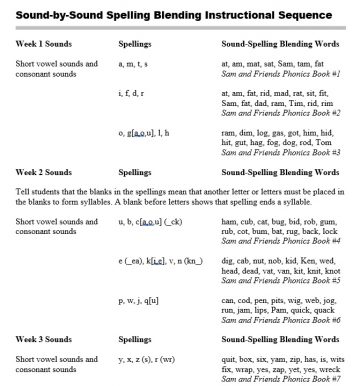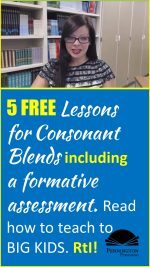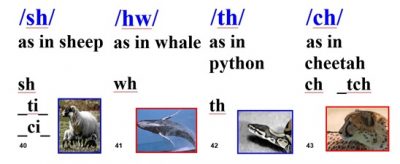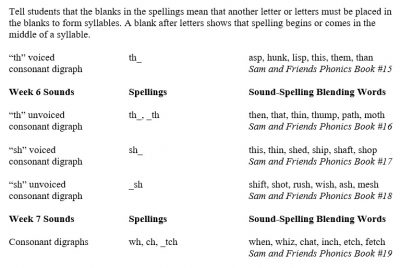Consonant Blends for Big Kids
In most explicit, systematic phonics programs, the short vowels (our most predictable and consistent sound-spelling relationships are taught first, along with the most frequently occurring consonant sounds. This is true whether using speech to print or print to speech instruction. I start with short /a/, m, t, and s. These give us quite a few words to study: as, am, mat, sat, Sam, tam, and fat. By way of reminder, they do not give us ma, as in “ma” and “pa.” A different sound altogether!
I will admit that these first four letter-sound correspondences don’t permit compelling reading. As much as I support connecting phonics instruction to reading, the first decodable book in my 54 Sam and Friends Reading Phonics Books is not a can’t put it down page-turner even with the two Heart Words (words with one or more non-phonetic parts) introduced with each eight-page book. But since this is a reading intervention program and the goal is get struggling readers brought up to grade-level as soon as possible, all short vowels and consonants are taught (and learned) within the first three weeks.
By that time, our Book 7 Sam and Friends story with teenage cartoon characters and complex plots is getting pretty fun to read. But hold onto your hats: the consonant blends are going to open up a whole new world for reading. Wahoo!
Now, an important disclaimer… Not all reading specialists advocate teaching consonant blends. Dr. Louisa Moats would say that there is no such phoneme as /bl/, so we should only teach the /b/ and /l/ as separate phonemes. Of course, she is right; however, once we teach the separate phonemes and reinforce them a beginning, medial, and ending sounds, most teachers believe that the consonant blends are better orthographically mapped when practiced together.
To learn how to quickly teach consonant blends to big kids and adults (those who just didn’t get it the first time around), I’ll provide a working definition and a few teaching tips.
How to Teach Consonant Blends
Definition: Consonant blends are two (or three) letters which make two (or three) sounds. We have both beginning and ending consonant blends. Remember that blends are not digraphs. Consonant digraphs are two (or three) letters which form one sound.
Qualification: The consonant blends are not to be memorized, nor “mushed” together as one sound. By definition, a consonant blend includes two or three phonemes (speech sounds) that are represented as graphemes (spellings). Each phoneme must retain its own sound as we teach students the consonant blends.
Diagnosis: The first step is to determine what is missing from the your students’ knowledge of the consonant blends phonics patterns. Your big kids and adults are smarter than beginning pre-K, kinder, or first graders. They can catch on quickly if taught properly. In fact, I see two mistakes canned reading intervention programs make all-too-often: 1. The program doesn’t move fast enough. Believe me, your remedial readers have heard this stuff all before. They will tune you out and lull themselves into “remedial reading sleep-state” or jump into poor behavior mode if the instructional pace is not brisk and demanding. 2. All whole-class instruction and no individual or small group gap-filling. Teachers want to be thorough. They want to teach the whole thing. I agree, but the whole-class direct instruction of sound-by-sound blending and syllabication should be coupled with concurrent, assessment-based gap-filling. Having taught reading intervention courses to grades 3-6 elementary, 7-8 middle school, 9-10 high school, and community college students, I can assure you that the most successful remedial reading instruction includes A through Z whole-class teaching of the sound-spellings and gap-filling, assessment-based individualized instruction.
Application… Use a systematic, explicit, and hurried instructional scope and sequence for phonics and syllables instruction. (You’ll get my 16-week plan with your FREE download.) Connect the instruction with reading decodable text for authentic practice. Also administer prescriptive diagnostic phonics assessments that will allow you to teach to individual student deficits while you are teaching and students are practicing the whole thing. Teachers have used my FREE reading assessments for years to pinpoint phonemic awareness, phonics, and sight words deficits. These assessments will inform your instruction. For the purposes of this article, the Consonant Sounds Phonics Assessment pinpoints which consonant blends sound-spellings students have not yet mastered.
The second step is to follow a research-tested instructional scope and sequence. The instructional scope and sequence should guide both your whole-class phonics and syllabication instruction and your assessment-based individualized (or in groups) instruction. For example, teach the consonant sounds before teaching consonant blends in both both your sound-by-sound blending and in assessment-based mini-lessons, guided reading, worksheets, etc.
Teachers should layer in a mix of beginning and ending consonant blends by frequency of use and by utility. Because our task is to teach reading, not to teach phonics as our end-goal, we have to connect instruction to authentic reading practice. Now by authentic, I mean narrative and expository reading practice, not just words or sentence practice. In other words, fist teach the high utility consonant blends which are connected to decodable books. Your students need targeted practice.
The third step is to group students who have demonstrated that they have not yet achieved mastery with the consonant blend sound-spellings. Grouping is just more efficient than purely individual instruction. Teachers use a variety of small group formats. Literacy centers have become a popular option to provide remedial instruction within some centers (stations), while offering grade-level and/or accelerated instruction in other centers. Mini-lessons and collaborative or individual worksheets can work well in groups. Guided reading, if focused on targeted sound-spellings, can do the job. I like and have used a combination of approaches, usually beginning a group with quick instruction, followed by individualized practice, and ending (not necessarily on the same day) with formative assessment and re-teaching as necessary. By the way, I’m a big advocate of student self-correction of their own practice. Kids do learn from their own mistakes.
The fourth step is to develop and use formative assessments to determine mastery. Big kids and adults improve reading most when the instruction is designed by comprehensive, teachable diagnostic assessments and is adjusted as needed by the results of quick, pinpoint formative assessments. In the FREE five consonant blend lessons, the fifth lesson is a one-minute formative assessment. You’ll know whether students have or have not mastered the consonant blends. Teachers need to have back-up lessons in case the student does not master the consonant blends on the formative assessment. A solid foundation will allow students to learn additional reading skills.

The Science of Reading Intervention Program
The Science of Reading Intervention Program: Word Recognition includes explicit, scripted instruction and practice with the 5 Daily Google Slide Activities every reading intervention student needs: 1. Phonemic Awareness and Morphology 2. Blending, Segmenting, and Spelling 3. Sounds and Spellings (including handwriting) 4. Heart Words Practice 5. Sam and Friends Phonics Books (decodables). Plus, digital and printable sound wall cards and speech articulation songs. Print versions are available for all activities. First Half of the Year Program (55 minutes-per-day, 18 weeks)
The Science of Reading Intervention Program: Language Comprehension resources are designed for students who have completed the word recognition program or have demonstrated basic mastery of the alphabetic code and can read with some degree of fluency. The program features the 5 Weekly Language Comprehension Activities: 1. Background Knowledge Mentor Texts 2. Academic Language, Greek and Latin Morphology, Figures of Speech, Connotations, Multiple Meaning Words 3. Syntax in Reading 4. Reading Comprehension Strategies 5. Literacy Knowledge (Narrative and Expository). Second Half of the Year Program (30 minutes-per-day, 18 weeks)
The Science of Reading Intervention Program: Assessment-based Instruction provides diagnostically-based “second chance” instructional resources. The program includes 13 comprehensive assessments and matching instructional resources to fill in the yet-to-be-mastered gaps in phonemic awareness, alphabetic awareness, phonics, fluency (with YouTube modeled readings), Heart Words and Phonics Games, spelling patterns, grammar, usage, and mechanics, syllabication and morphology, executive function shills. Second Half of the Year Program (25 minutes-per-day, 18 weeks)
The Science of Reading Intervention Program BUNDLE includes all 3 program components for the comprehensive, state-of-the-art (and science) grades 4-adult full-year program. Scripted, easy-to-teach, no prep, no need for time-consuming (albeit valuable) LETRS training or O-G certification… Learn as you teach and get results NOW for your students. Print to speech with plenty of speech to print instructional components.
Get the SCRIP Comprehension Strategies FREE Resource:
![]()
Get the Diagnostic ELA and Reading Assessments FREE Resource:





